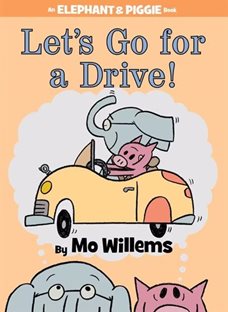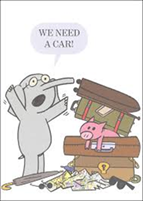This month’s Book Nook topic is...
Making Predictions with Let’s Go for a Drive


By Mo Willems
|
To really understand a story, children need to look for meaning beyond the information provided in the words and pictures. In other words, readers must often read “between the lines” to fully grasp the meaning of a story. One way to support reading comprehension is to encourage children to predict what might happen next. When children are encouraged to predict, they draw on their knowledge, experiences, and reasoning skills to deepen their understanding of the story.
Let’s get started!
|
Why we chose this book
Let’s Go for a Drive is all about making a plan! Gerald and Piggie are planning all the things they will bring when they go for a drive, but their plan goes astray when the realize that they don’t have a car! This engaging story offers many opportunities for children to think about and predict what will happen next.
Predicting Before Your Start Reading
Before you read a book for the first time, you can begin by looking at the cover with the child and encouraging them to predict what the story is about. You could say, “The title of this story is Let’s Go for a Drive. I’m wondering what they will bring on their drive.” Then wait to see if the child responds. If the child responds, you could say, “Maybe. Let’s read the book and find out”, or you could offer a comment, such as, “I think they might bring water, in case they get thirsty on their drive.”
The First Reading
The first time you read a story is an excellent opportunity to make predictions, because the child does not yet know the answer. Predicting is not about being right or wrong – it is a skill that focuses on thinking about what might happen.
You can encourage the child to predict by:
- Asking questions that build understanding
- Making “thinking-out-loud” comments
In Let’s Go for a Drive, you can help the child to make predictions by asking questions that build understanding such as:
- “Where do you think they are going?”
- “What do you think will happen next?
If the child has difficulty answering these questions, you can provide an answer and keep reading.
You can also use thinking-out loud comments. These comments allow the child to see how you are trying to understand the story.
 Here are a few examples of ways to make predictions using thinking-out-loud comments with Let’s Go for a Drive:
Here are a few examples of ways to make predictions using thinking-out-loud comments with Let’s Go for a Drive:
- “I think they might be going to visit their friend.”
- “I’m trying to figure out what else they will bring.”
- “Since they don’t have a car, maybe they will take a bus.”
Unlike questions, comments don’t require a response. However, if you make a comment and then wait, the child may respond and add their own ideas. z
Continue Predicting After You Read the Story
When you finish reading the book with the child, you can continue to predict by asking questions and making comments about what might happen after the story ends e.g. “I wonder what they are going to do next?”
You can also nurture predicting skills beyond books. Consider practicing predicting skills during play and routines to promote the language for thinking and learning during conversations throughout the day.
Happy reading!
More resources
The strategies in this Book Nook post are drawn from Hanen’s practical, research-based guidebooks for building emergent literacy. Explore the links below to learn more about how these guidebooks can support you.
We’ll let you know when a new Book Nook topic
has been posted!
Return to Book Nook